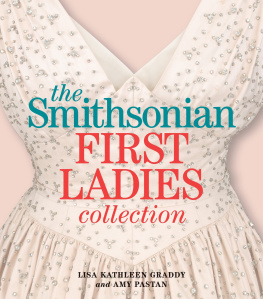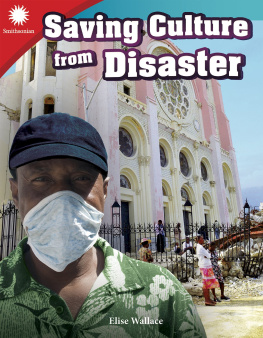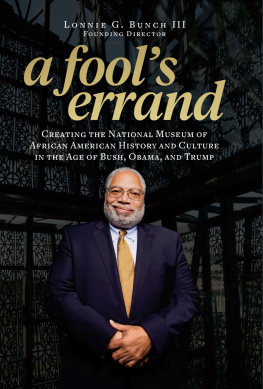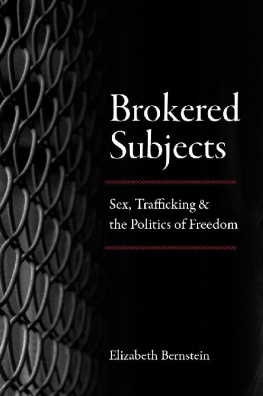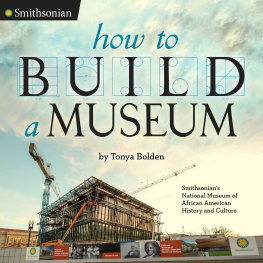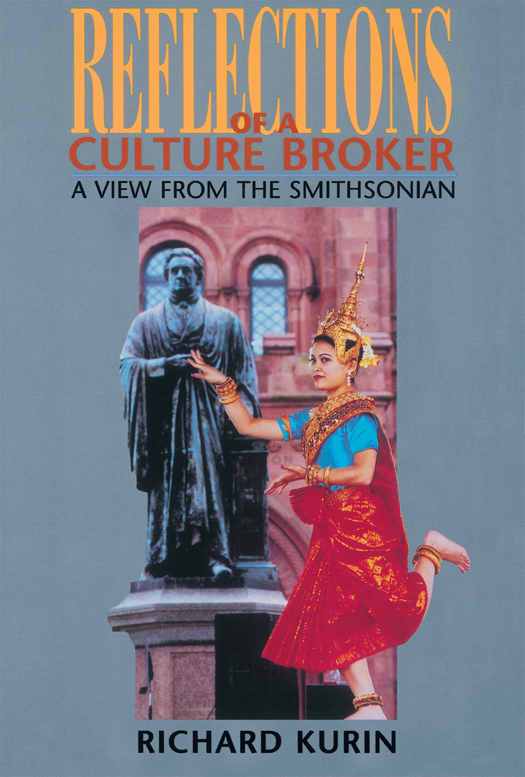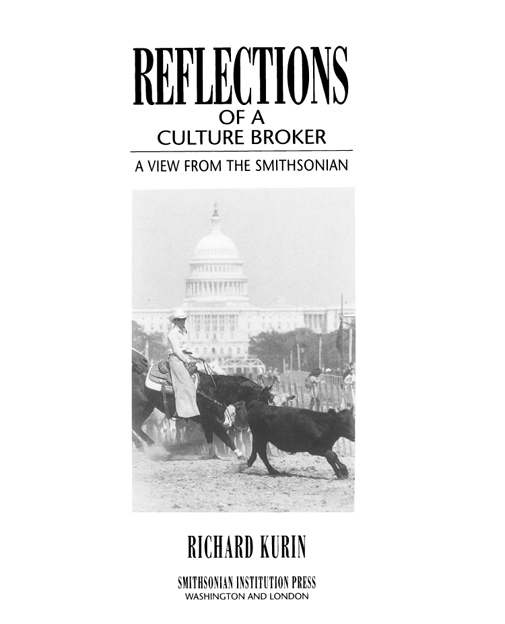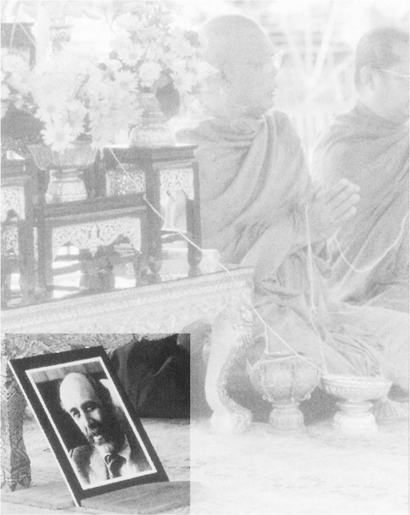1997 by the Smithsonian Institution
All rights reserved
Copy editor: Jan McInroy
Production editors: Jenelle Walthour and Ruth Thomson
Designer: Linda McKnight
Library of Congress Cataloging-in-Publication Data
Kurin, Richard, 1950
Reflections of a culture broker : a view from the Smithsonian / Richard Kurin.
p. cm.
ISBN 1-56098-789-8 (cloth : alk. paper). ISBN 1-56098-757-X (pbk.)
eBook ISBN: 978-1-935623-65-6
1. Smithsonian InstitutionManagement. 2. Smithsonian InstitutionPublic relations. 3. Anthropological museums and collectionsDistrict of ColumbiaManagement. 4. Museum exhibitsPolitical aspectsUnited States. 5. Museum techniquesUnited States. 6. Culture conflictUnited States. 7. United StatesCultural policy. I. Title.
GN36.U62D5775 1997
069.09753dc21 97-6974
British Library Cataloguing-in-Publication Data is available
For permission to reproduce illustrations appearing in this book, please correspond directly with the owners of the works, as listed in the individual captions. The Smithsonian Institution Press does not retain reproduction rights for these illustrations individually or maintain a file of addresses for photo sources.
On : In 1982 the occupational folklife of horsemen was featured as part of the Oklahoma state program. Here cowgirl Sheri Lynn Close demonstrates steer cutting. Photo by Dane Penland, courtesy Smithsonian Institution.
On : Thai Buddhist monks from the Wat Thai in Silver Spring, Maryland, honor Ralph Rinzler at a memorial service at the 1994 Festival of American Folklife. Photo by Richard Strauss, courtesy Smithsonian Institution.
On page vii: Sakaya Khunpolpitak, a traditional temple painter, drew this interpretation of the 1994 Thailand program site at the Festival of American Folklife on the National Mall.
v3.1
For my family, friends, and colleagues,
with respect to my teachers,
and in memory of Ralph Rinzler,
who combined knowledge, artistry, service, and justice
in the most creative and wonderful ways
CONTENTS
FOREWORD
T he Smithsonian Institution represents a wonderful ideathe public pursuit and sharing of knowledge. Over its history the Smithsonian has played a key role in representing the knowledge of American and world cultures through its publications, museums, research work, and public programs to millions upon millions of visitors, as well as scholars and policymakers.
These days, there seems to be more at stake than ever before in how peoples and cultures are representedespecially in a highly visible place like the Smithsonian. Our world is getting smaller, with cultures in increasing contact, and even conflict. Therefore, representing someones culture, even our own, is no easy task. It is not a matter of just nailing a picture on the wall or putting an object in a case. Rather, it requires knowledge and skill, a head and heart for persuasion, negotiation, and deliberation.
Richard Kurin has been at the center of a number of major initiatives, exhibits, programs, and projects, during my tenure, and that of my predecessors Robert McC. Adams and S. Dillon Ripley. His experiences and insights are thought-provoking and illuminate the challenges of the Smithsonians position and mission. His perspectives are his own, but I think they accurately reflect the richness of intellectual and professional discourse that characterizes work at the Smithsonian. I believe readersgeneral, scholarly, and professionalwill find this book a refreshing look at how peoples and cultures are publicly represented in late twentieth-century America.
I. Michael Heyman
Secretary
Smithsonian Institution
PREFACE
T his book is about how various types of major cultural presentationsexhibits, museums, and festivalsare brokered through the Smithsonian Institution. It offers a descriptive and analytic look at this process within a national and international context. My intention is to provide a sorely needed casebook of professional practice. Analyses of how cultural understanding and presentation are developed, enacted, and situated within the public arena illustrate the interplay of scholarship and politics, ethics and advocacy, government institutions and social communities, abstract theories and technical methodologies. I trust that this book will narrow the gap between academic talk and professional action. I am hopeful that it will challenge fellow intellectuals to engage in the formulation of cultural policy, to influence the growing culture industry, and to enliven postdisciplinary studies of culture.
I offer, first, a prologue not of institutional practice but of my own, as an anthropologist in the field. The essay demonstrates quite clearly how my very identity was brokered within another society. Through fieldwork I learned how different conceptual schemes can be brought to bear in a cross-cultural experience, how others could take control of the way I was culturally represented, and how such representations could be negotiated and experienced. Humility is a good but tough teacher. I learned that the culture broker could himself be brokeredand this insight has served me well in my work for the Smithsonian.
The introductory chapter examines the structure of brokering itself and compares the curatorial art of cultural representation to other brokerage rolesin politics, the stock market, and marriage. The first part of the book examines how Smithsonian research and curatorial roles, displays, exhibits, museums, programs, and departments are conceived, internally debated, questioned, and sometimes resolved. One essay explores the brokering of the Smithsonian, how it sought to represent itself, its treasures, and its mission to the American public during its 150th anniversary. Subsequent essays explore how curators broker and negotiate the meaning of objects and collections, how staff failed to understand our role and that of the public and the veterans in the Enola Gay exhibition, how some of us debate the purposes of museums, departments, and programs.
The second part of the book examines major public programs produced, in part by the Smithsonian, for the first presidential inaugural of Bill Clinton, the Festival of India, and the bicentennial of the White House, among others. Complex issues arise: How to represent the unity of America after the divisive 1992 presidential election? How to represent another country? How to illustrate the culture of a famous institution? One essay analyzes how Smithsonian staff dealt with Israelis and Palestinians on the proposed representation of Jerusalem to the American publicand how the effort both succeeded and failed. Another essay explains our work with the Olympic Games in Atlanta and how differing ideas of the American South and ways of conveying them to an international audience numbering in the billions were debated and decided for the Olympic Arts Festival. The book concludes with an assessment of scholarly and curatorial roles in todays complex society and offers suggestions for fair, ethical, knowledge-based understandings and presentations of culture in an increasingly commercialized and politicized environment.
ACKNOWLEDGMENTS
T his book is written by an insider, but it is not an official accounting of Smithsonian policies, activities, and decisions. Each essay is based on my own firsthand knowledge of the Smithsonian and the particular cultural representations discussed. As the director of the Smithsonians Center for Folklife Programs and Cultural Studies, I have been a principal in most of the projects. For others, I have been involved in formal ways, as chair of the Smithsonians 150th Anniversary Program Committee, as an invited discussant for the Smithsonian Council, as chair of the Council of Information and Education Directors, as a planner and summarizer for the joint SmithsonianUniversity of Michigan symposium on the


